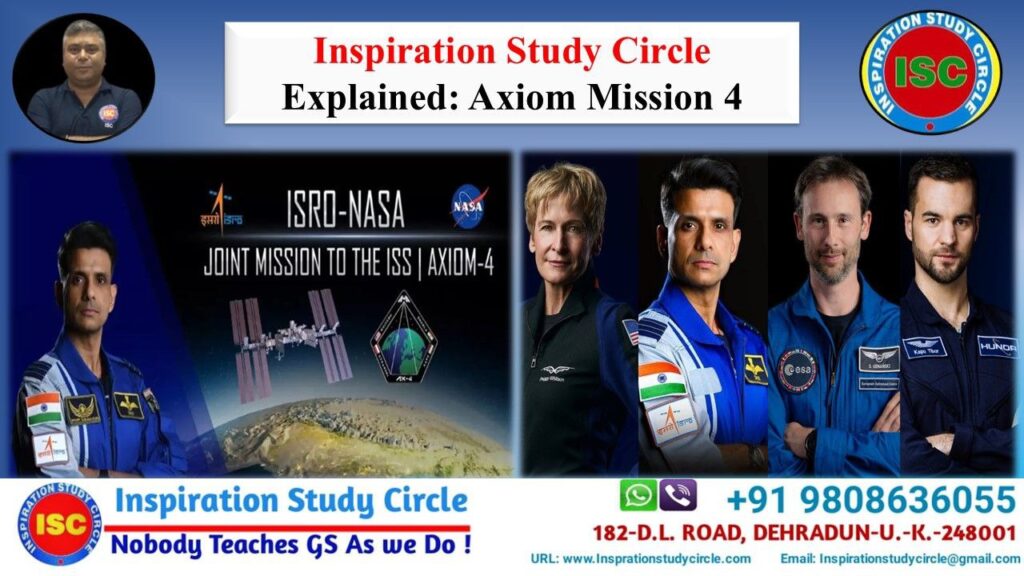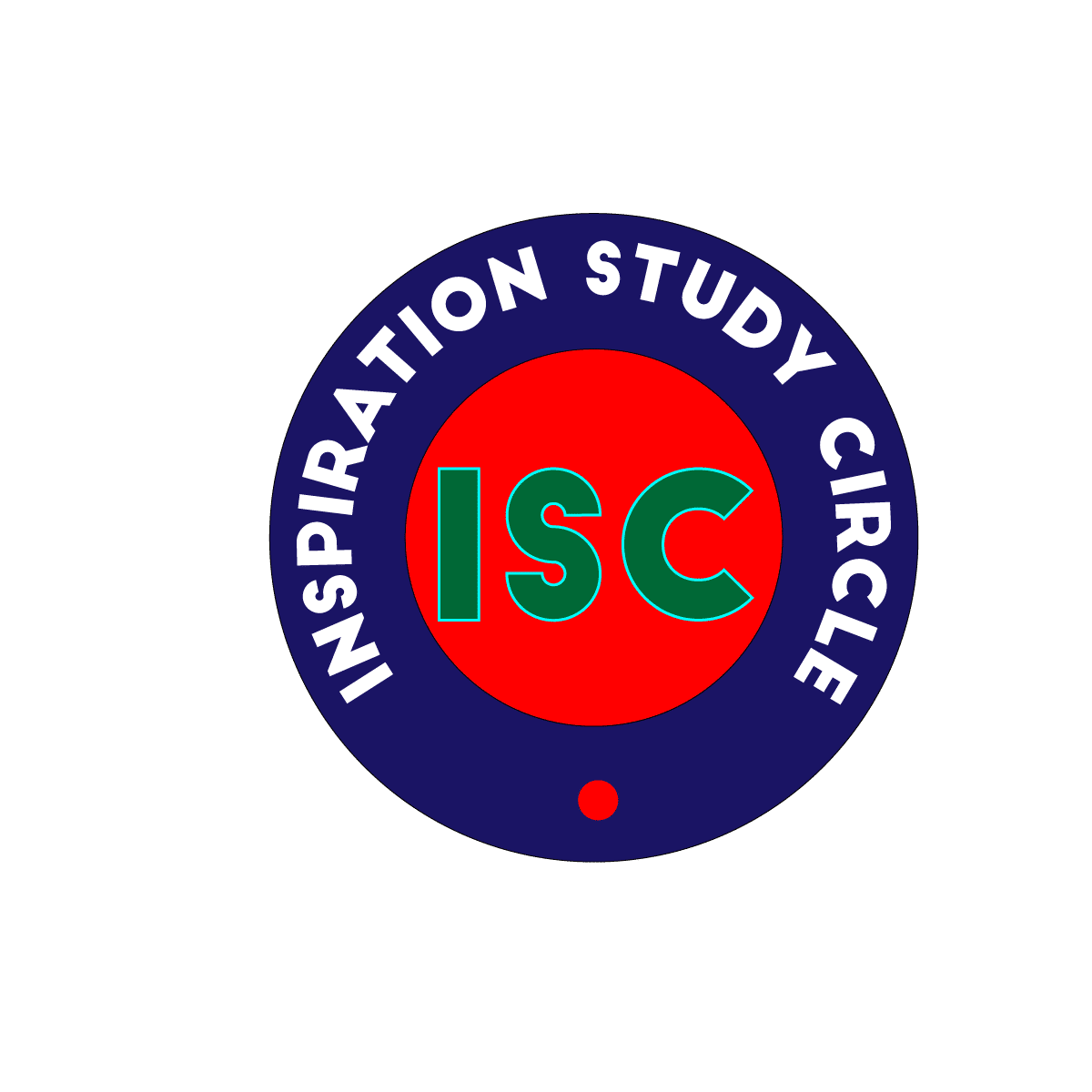Explained: Axiom Mission 4
Table of Contents
Inspiration Study Circle Explained: Axiom Mission 4
Axiom Mission 4 (Ax‑4) was a private crewed spaceflight to the International Space Station (ISS) operated by Axiom Space in partnership with SpaceX and NASA. The mission launched atop a SpaceX Falcon 9 Block 5 rocket, which placed the Crew Dragon Grace spacecraft into low Earth orbit. This was the maiden flight of Grace (C213), the fifth and final Crew Dragon capsule to be built.
The launch was originally scheduled for June 11, 2025, from Launch Complex 39A at the Kennedy Space Center, but was scrubbed for a liquid oxygen leak. A separate leak in the ISS’s Zvezda module led to an additional two-week launch delay. The mission was eventually launched on June 25, 2025, at 06:31:52 UTC, for an 18-day stay at the ISS before undocking and splashing down in the Pacific Ocean off the coast of San Diego on July 15, 2025, at 09:31:36 UTC.

Crew and Members
The four-person crew included commander Peggy Whitson, an Axiom Space employee and former NASA astronaut; pilot Shubhanshu Shukla of the Indian Space Research Organisation (ISRO); and mission specialists Sławosz Uznański-Wiśniewski, a European Space Agency (ESA) project astronaut from Poland, and Tibor Kapu, representing the Hungarian Space Office.
The mission marked the first government-sponsored human spaceflight in over 40 years, and only the second overall, for India, Hungary, and Poland. Each of these countries previously flew one astronaut as part of the Soviet Union’s Interkosmos program.
Prime crew | |
Astronaut | |
Commander | Peggy Whitson, Axiom Space |
Pilot | Shubhanshu Shukla, ISRO |
Mission Specialist | Sławosz Uznański-Wiśniewski, ESA/POLSA |
Mission Specialist | Tibor Kapu, HSO |
Backup crew | |
Astronaut | |
Commander | |
Pilot | |
Mission Specialist | |
Significance for ISRO’s Gaganyaan
Ax‑4 represents a milestone for the Indian Human Spaceflight Programme, integrating with ISRO‘s Gaganyaan initiative. While Gaganyaan remains India‘s independent crewed program, Ax‑4 provides the first opportunity for an Indian astronaut—Shubhanshu Shukla—to fly on a commercial mission to the ISS. Shukla will conduct experiments developed by ISRO and Indian institutions, including studies of cognitive effects of screen use, microbial adaptation, muscle atrophy, and crop resilience in microgravity.
According to ISRO, the mission provided practical experience in the intricacies of crew-ground coordination, real-time health telemetry, medical and psychological preparation, international crew integration, and experiment execution. For the Indian Human Spaceflight Programme, it will have a direct impact on astronaut preparedness, safety validation, and mission planning.
Significance of Ax-4 for India
Axiom-4 (Ax-4), with Indian astronaut Shubhanshu Shukla on board, is significant for India as it provides valuable experience in human spaceflight, supports the Gaganyaan program, and enhances India’s global standing in space exploration. The mission allows India to test technologies, conduct research in microgravity, and gain operational experience that will be crucial for its future space missions.
Specific benefits for India:
- Gaganyaan Support: Ax-4 serves as a crucial stepping stone for India’s Gaganyaan mission, providing hands-on experience in crew operations, microgravity research, and space biology.
- Strategic and Technological Advancement: Participating in Ax-4 strengthens India’s position in the global space arena and supports its long-term goals, like an Indian space station and a crewed lunar mission.
- Global Standing: India’s active involvement in Ax-4 demonstrates its technological competence and boosts its international standing in space exploration.
- Economic Growth: The mission fosters private sector participation and attracts foreign investments, potentially contributing to India’s share in the global space economy.
- Youth Engagement and STEM Promotion: Ax-4 inspires the youth, promotes STEM education, and helps build a skilled talent pipeline for India’s expanding space sector.
- Scientific Research: The mission facilitates research in areas like microgravity, human physiology, and Earth observation, potentially leading to breakthroughs.
- Operational Testbed: Ax-4 acts as a valuable testbed for long-duration crewed missions, providing insights into astronaut well-being, system behavior, and multi-agency coordination.
- Commercialization of Space: India’s participation in Ax-4 highlights the growing role of private companies in space exploration and the potential for commercial space services.
In essence, Axiom-4 is a significant step for India, offering a blend of practical experience, strategic advantages, and global recognition in the evolving landscape of human spaceflight.
The Axiom Mission 4 (Ax-4) launched on June 25, 2025, at 2:31 a.m. from NASA’s Kennedy Space Center in Florida. The mission crew successfully docked with the International Space Station (ISS) on June 26, 2025, and undocked on July 14, 2025, to begin their return journey. The SpaceX Dragon spacecraft splashed down in the Pacific Ocean on July 15, 2025, completing the mission.
Here's a more detailed chronology: Pre-Launch
- Preparations: The crew underwent intensive pre-launch training, including briefings, simulations, and system familiarization at NASA’s Kennedy Space Center.
- Health Stabilization: A health stabilization quarantine was implemented to ensure the crew’s fitness.
- Launch Postponements: The launch was initially delayed due to issues with the Falcon 9 vehicle and unfavorable weather. Further delays occurred due to technical issues like oxygen leakage and an anomaly in an engine actuator.
Launch and Docking:
- Launch: The Falcon 9 rocket carrying the Axiom-4 crew launched on June 25, 2025, at 2:31 a.m. from NASA’s Kennedy Space Center.
- Docking: Approximately 28 hours later, the SpaceX Dragon spacecraft docked with the space-facing port of the ISS Harmony module.
Mission Duration:
- Experiments and Research: The crew conducted various scientific experiments, including studies on human health, life in space, and the potential for supporting life on long-duration missions.
- Cargo: The mission returned with over 580 pounds of cargo, including NASA hardware and data from over 60 experiments.
Return:
- Undocking: The Axiom-4 crew undocked from the ISS on July 14, 2025, at 7:15 a.m.
- Return Journey: The SpaceX Dragon spacecraft began its return journey to Earth.
- Splashdown: The spacecraft splashed down in the Pacific Ocean on July 15, 2025.
- Recovery: SpaceX recovery teams promptly recovered the capsule.
About Group Captain Shubhanshu Shukla
Group Captain Shubhanshu Shukla, a distinguished pilot in the Indian Air Force (IAF), has been handpicked as one of the four astronauts for the Indian Space Research Organisation’s (ISRO) historic Gaganyaan mission—the nation’s inaugural human space flight endeavor.
His journey began when he was commissioned into the IAF fighter wing in June 2006. As a combat leader and seasoned test pilot, he boasts an impressive 2,000 hours of flight experience across various aircraft, including the Su-30 MKI, MiG-21, MiG-29, Jaguar, Hawk, Dornier, and An-32. His ascent to the rank of group captain in March 2024 reflects his exceptional contributions.
In 2019, Shukla received a momentous call from ISRO. He embarked on rigorous training at the Yuri Gagarin Cosmonaut Training Center in Star City, Moscow, Russia—a year-long preparation that would shape his destiny. On February 27, 2024, Indian Prime Minister Narendra Modi unveiled Shukla as one of the elite astronauts undergoing intensive training for India’s maiden human spaceflight mission, Gaganyaan, scheduled for launch in 2027.
Shukla was honored and excited as he prepared to pilot the historic Axiom Mission 4 (Ax-4) to the International Space Station (ISS), leaving an indelible mark on India’s remarkable advancements in human space exploration.
The Gaganyatris of the Gaganyaan Mission
The four astronauts selected for India’s Gaganyaan mission are Group Captain Prashanth Balakrishnan Nair, Group Captain Ajit Krishnan, Group Captain Angad Pratap, and Wing Commander Shubhanshu Shukla. They are all officers in the Indian Air Force and have extensive experience as test pilots.
Here’s a bit more about them:
- Group Captain Prashanth Balakrishnan Nair: He is also a backup crew member for the Axiom-4 mission.
- Group Captain Ajit Krishnan: He is one of the four astronaut-designates.
- Group Captain Angad Pratap: He is also one of the four astronaut-designates.
- Wing Commander Shubhanshu Shukla: He is also one of the four astronaut-designates. He is also the mission pilot and prime crew member for the Axiom-4 mission.
The Gaganyaan mission, India’s first human spaceflight program, is scheduled for its maiden crewed launch in early 2027
Disclaimer: The information and Statistics are taken from the following sources- Wikipedia, The Hindu, and the official webpage of Axiom Mission.
Recent Post

The Viksit Bharat – Guarantee for Rozgar and Ajeevika Mission (Gramin) Bill, 2025
The Viksit Bharat – Guarantee for Rozgar and Ajeevika Mission (Gramin) Bill, 2025 Table of Contents The Viksit Bharat – Guarantee

How to Prepare for UKPCS 2026 in Six Months
How to Prepare for UKPCS 2026 in Six Months Table of Contents ISC- How to Prepare for UKPCS 2026 in

UKPSC Upper and Lower PCS Combined Batch for 2026- 2027
UKPSC Upper and Lower PCS Combined Batch for 2026-2027 Table of Contents Unlocking Uttarakhand’s Civil Services: The Power of UKPCS

Explained: Russian President Vladimir Putin’s State Visit to India
Explained: Russian President Vladimir Putin’s State Visit to India Table of Contents Russian President Vladimir Putin conducted a state visit

UPPSC Upper PCS 2025: Mains Test Series and Answer Writing
UPPSC Upper PCS 2025: Mains Test Series and Answer Writing Table of Contents Inspiration Study Circle- Dehradun The UPPSC PCS

Explained: The Sanchar Saathi App
The Sanchar Saathi App Table of Contents The Sanchar Saathi app is a security and user-protection platform developed by India’s Department of Telecommunications (DoT) to help users manage mobile connections, report fraud, and locate lost phones
